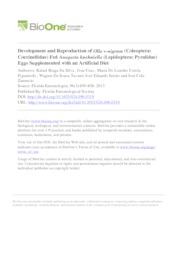Development and reproduction of Olla v-nigrum (Coleoptera: Coccinellidae) fed Anagasta kuehniella (Lepidoptera: Pyralidae) eggs supplemented with an artificial diet.
Development and reproduction of Olla v-nigrum (Coleoptera: Coccinellidae) fed Anagasta kuehniella (Lepidoptera: Pyralidae) eggs supplemented with an artificial diet.
Author(s): SILVA, R. B. da; CRUZ, I.; FIGUEIREDO, M. de L. C.; TAVARES, W. de S.; SERRÃO, J. E.; ZANUNCIO, J. C.
Summary: Olla v-nigrum Mulsant (Coleoptera: Coccinellidae) preys on eggs and larvae of Coleoptera and Lepidoptera and on aphids in arboreal plants. Alternative prey supplemented with artificial diets may be used to mass rearing Coccinellidae predators for biological control programs. This study assessed the development and reproduction of O. v-nigrum fed Anagasta kuehniella Zeller (Lepidoptera: Pyralidae) eggs supplemented with an artificial diet. Adults of O. v-nigrum were collected from Caesalpinia peltophoroides Benth. (Fabales: Fabaceae) and taken to the laboratory. Three male + female couples were fed on A. kuehniella eggs and an artificial diet (100 g of yeast, 40 g of honey, 0.5 g of ascorbic acid and 60 mL of water). Eight male + female couples obtained from this initial generation were subjected to the same procedure in order to assess the effects on subsequent generations. The mean number of eggs per egg mass was 11.7 ± 0.7 with a viability of 54.8 ± 2.9% and an incubation period of 3.1 ± 0.02 days. The durations of instars I, II, III and IV and the durations of the larval, pre-pupal, pupa and larva to adult stages were 2.4 ± 0.3, 1.8 ± 0.2, 2.0 ± 0.3, 5.8 ± 0.1, 12.1 ± 0.3, 1.0 ± 0.01, 4.0 ± 0.2 and 17.1 ± 0.5 days, respectively. The viabilities of the larval, pre-pupal and pupal stages of this predator were 46.3 ± 4.5%, 90.0 ± 5.0% and 100%, respectively. The diet and other methods employed in this study were adequate for laboratory rearing of O. v-nigrum but, because of the low viabilities of the eggs and immature stages observed with these methods, further improvements will be necessary for successful mass rearing of this valuable predator.
Publication year: 2013
Types of publication: Journal article
Unit: Embrapa Maize & Sorghum
Observation
Some of Embrapa's publications are published as ePub files. To read them, use or download one of the following free software options to your computer or mobile device. Android: Google Play Books; IOS: iBooks; Windows and Linux: Calibre.
Access other publications
Access the Agricultural Research Database (BDPA) to consult Embrapa's full library collection and records.
Visit Embrapa Bookstore to purchase books and other publications sold by Embrapa.

